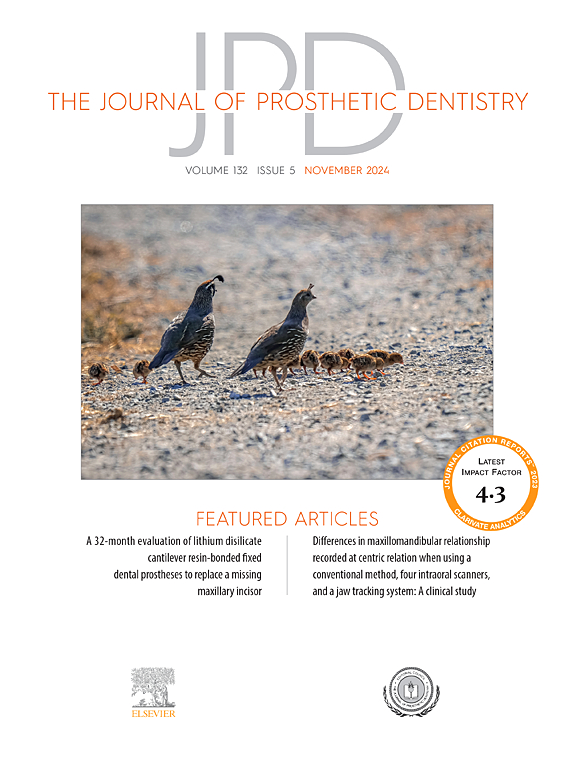Accuracy of markerless registration methods of DICOM and STL files used for computerized surgical guides in mandibles with metal restorations: An in vitro study
IF 4.3
2区 医学
Q1 DENTISTRY, ORAL SURGERY & MEDICINE
引用次数: 0
Abstract
Statement of problem
Digital imaging and communications in medicine (DICOM) files together with surface scans must be accurately registered in virtual implant planning software programs to match real-life dimensions and ensure correct plan transfer through computer-aided manufactured surgical guides.
Purpose
The purpose of this in vitro study was to evaluate the accuracy of 3 different registration methods of DICOM data with and without metal restorations and a metal artifact reduction (MAR) tool for surface scans.
Material and methods
Thirteen dentate mandibles were assigned to each group of this study (n=39). Baseplate wax was adapted to the bone surfaces of each mandible, and 5 radiopaque markers were attached. A desktop scanner was used to obtain control scans. The groups of metal-free mandibles (MFM) and mandibles with metal restorations (MRM) were scanned to obtain DICOM data without a MAR tool. Additional DICOM data for the MRM were obtained with the MAR tool (MRM-MAR). Point-based registration (PBR), best-fit registration (BFR), and automatic registration (AR) were used to align standard tessellation language (STL) and DICOM data, and 3 data sets were exported. Radiographic markers on each data set were compared with those on the control scan, and positional deviations were calculated and statistically evaluated with 1-way ANOVA followed by multiple pairwise comparisons, independent samples t test, and 2-way ANOVA (α=.05).
Results
Within each group, PBR had the lowest deviation values with statistical significance in the MFM and the MRM-MAR groups (P<.001). AR showed failure in the MRM and the MRM-MAR groups. Statistically significant differences were found on comparing the average deviations among the 3 groups for PBR only (P<.001). No association was found between deviation values and the presence or absence of metal restoration, while a positive association was found with the type of registration method (P<.001).
Conclusions
PBR had the highest accuracy level compared with AR and BFR methods. An increase in the number of calculations resulted in more deviation values. The MAR tool had a positive effect on PBR in mandibles with metal restorations.
下颌骨金属修复体计算机化手术导板所用 DICOM 和 STL 文件的无标记注册方法的准确性:体外研究
问题陈述:医学数字成像和通信(DICOM)文件以及表面扫描必须在虚拟种植规划软件程序中准确注册,以匹配现实生活中的尺寸,并确保通过计算机辅助制造的手术导板进行正确的计划转移。目的:本体外研究的目的是评估带金属修复体和不带金属修复体的 DICOM 数据的 3 种不同注册方法以及表面扫描的金属伪影减少工具(MAR)的准确性:本研究的每组均有13颗有齿下颌骨(n=39)。在每个下颌骨的骨表面涂上基板蜡,并贴上 5 个不透射线的标记。使用台式扫描仪进行对照扫描。对无金属下颌骨(MFM)组和有金属修复体的下颌骨(MRM)组进行扫描,以获得 DICOM 数据,而不使用 MAR 工具。使用 MAR 工具(MRM-MAR)获得 MRM 的其他 DICOM 数据。使用基于点的配准 (PBR)、最佳拟合配准 (BFR) 和自动配准 (AR) 对齐标准细分语言 (STL) 和 DICOM 数据,并导出 3 组数据。将每个数据集上的放射标记与对照扫描上的标记进行比较,计算位置偏差,并通过单因素方差分析、多对比较、独立样本 t 检验和双因素方差分析(α=.05)进行统计评估:在各组中,PBR 的偏差值最低,在 MFM 和 MRM-MAR 组中具有统计学意义(PConclusions:与 AR 和 BFR 方法相比,PBR 的准确度最高。计算次数越多,偏差值越大。MAR工具对金属修复体下颌骨的PBR有积极影响。
本文章由计算机程序翻译,如有差异,请以英文原文为准。
求助全文
约1分钟内获得全文
求助全文
来源期刊

Journal of Prosthetic Dentistry
医学-牙科与口腔外科
CiteScore
7.00
自引率
13.00%
发文量
599
审稿时长
69 days
期刊介绍:
The Journal of Prosthetic Dentistry is the leading professional journal devoted exclusively to prosthetic and restorative dentistry. The Journal is the official publication for 24 leading U.S. international prosthodontic organizations. The monthly publication features timely, original peer-reviewed articles on the newest techniques, dental materials, and research findings. The Journal serves prosthodontists and dentists in advanced practice, and features color photos that illustrate many step-by-step procedures. The Journal of Prosthetic Dentistry is included in Index Medicus and CINAHL.
 求助内容:
求助内容: 应助结果提醒方式:
应助结果提醒方式:


